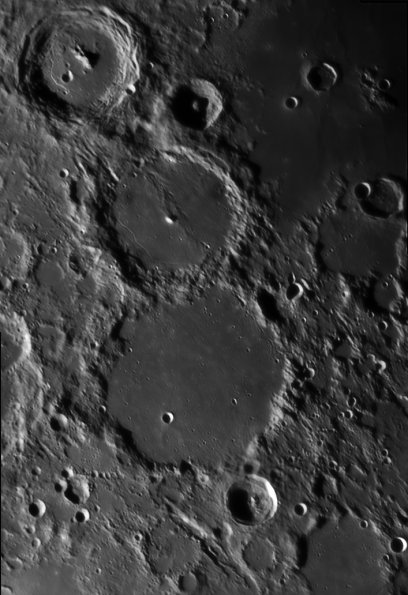Home | Gallery of astronomical pictures | Moon | Arzachel-Alphonsus-Ptolemaeus-Herschel_06.06.2014-144617-UT
(Freely adapted from Wikipedia)
Arzachel is a relatively young lunar impact crater (dia. 96 Km, dep. 3.6 Km) located in the highlands in the south-central part of the visible Moon, close to the zero meridian (the visible center of the Moon). It lies to the south of the crater Alphonsus, and together with Ptolemaeus further north the three form a prominent line of craters to the east of Mare Nubium. Arzachel is remarkably clear in its structure and a favorite telescope viewing subject for advanced amateur astronomers. The rim of Arzachel shows little sign of wear and has a detailed terrace structure on the interior, especially on the slightly higher eastern rim. There is a rough outer rampart that joins a ridge running from the north rim to southern rim of Alphonsus.
The rugged central peak of Arzachel is prominent, rising 1.5 kilometers above the floor, and is somewhat offset to the west with a bowed curve from south to north-northeast. There is a rille system named the Rimae Arzachel that runs from the northern wall to the southeast rim. A small crater lies prominently in the floor to the east of the central peak, with a pair of smaller craterlets located nearby.
Alpetragius is a lunar impact crater (dia. 40 Km, dept. 3.9 Km) located on the eastern edge of Mare Nubium, to the southwest of the much larger crater Alphonsus. In the southeast is the prominent crater Arzachel.
The most notable feature of this crater is the disproportionately large central peak, which forms a rounded rise that occupies almost the entire crater floor—one-third the crater diameter—and rises to a height of 2.0 km. There is evidence that this peak has been enlarged through volcanic eruptions, and there appears to be an eroded vent at its summit. The rim has fine terraces that slope down to near the edge of the central rise along the south and east sides. This outer wall is nearly round, with slight protrusions on the north and west sides.
The outer rim is joined to the southwest rim of Alphonsus by a rise in the surface. An arc of craterous depressions from the south rim of Alphonsus curves to the west, dividing Alpetagnius from Arzachel crater.
Alphonsus is an ancient impact crater (dia. 119 Km, dep. 2.7 Km) on the Moon. It is located on the lunar highlands on the eastern end of Mare Nubium, west of the Imbrian Highlands, and slightly overlaps the crater Ptolemaeus to the north. The surface of Alphonsus is broken and irregular along its boundary with Ptolemaeus. The outer walls are slightly distorted and possess a somewhat hexagonal form. A low ridge system of deposited ejecta bisects the crater floor, and includes the steep central peak designated Alphonsus Alpha (α). This pyramid-shaped formation rises to a height of 1.5 km above the interior surface. The floor is fractured by an elaborate system of rilles and contains three smaller craters surrounded by a symmetric darker halo. Alphonsus is one of the sites noted for transient lunar phenomena, as glowing red-hued clouds have been reported emanating from the crater.
Ptolemaeus is an ancient lunar impact crater (dia. 153 Km, dep. 2.4 Km) close to the center of the near side. The features of Ptolemaeus are highlighted when the Sun is at low angles during the first and last quarter. At full Moon the Sun is directly overhead and the crater contours become more difficult to discern.
Herschel is a lunar impact crater (dia. 41 Km, dep. 3.8 Km) located just to the north of the walled plain Ptolemaeus. The rim of this crater is generally circular, although the western side is straight. It has a well-defined edge that is not significantly worn, and the inner walls are terraced. On the rough inner floor is a notable central rise. This peak is offset slightly to the west of the crater midpoint.
Not yet rated

